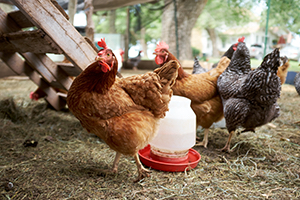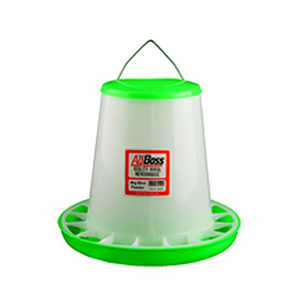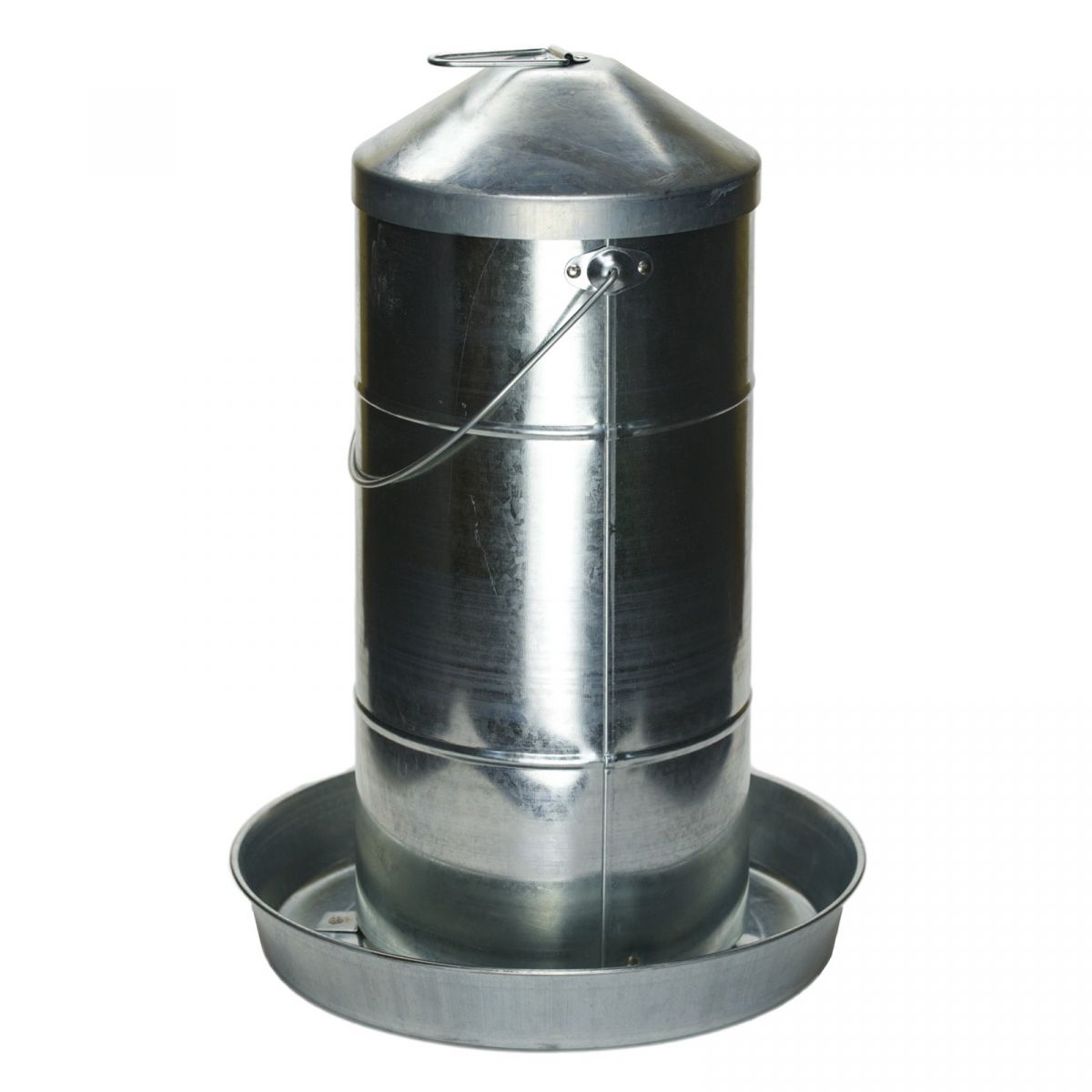Buying Poultry Feeders? Keep This in Mind
Date Posted: 6 October 2019
 In theory, feeding chickens is a simple thing to do. Once you know what chickens eat, you only need bowls for their food and drink. To the untrained eye, they are merely just that: containers where you place food and water.
In theory, feeding chickens is a simple thing to do. Once you know what chickens eat, you only need bowls for their food and drink. To the untrained eye, they are merely just that: containers where you place food and water.
However, it is more complicated than you think. When you go to the store and look for a poultry feeder, you will find that there are various styles to choose from. Believe it or not, some of them perform better than others. This is why choosing equipment for chickens is a complex process.
If you do not pick the right feeder for your chicken, they may not eat properly. Therefore, you run the risk of not meeting their food and drink needs. It is essential that you provide the right drinker and feeder for your flock. This way, they will get their nutrient requirements and you get your investment’s worth.
What is a Chicken Feeder?
Before we get to the buying guide, you may want to know first what a chicken or poultry feeder is. If you are new to poultry, a feeder is essentially a vessel that can hold food for your feathered animals. It may sound easy because you can simply have any container and store the food there. You can then present it to the chickens and they will start eating, right?
The problem here is that your flock would often be scratching and pecking. They can easily knock and toss the feeder. If you go for any container, they could end up not eating at all. Therefore, you need a superiorly designed product that will help your chickens eat.
The same goes for waterers or drinkers, so the chickens do not tip them over and create a watery mess. With the definition out of the way, here are the top things to consider before you purchase a poultry feeder:
1. Go for a specially designed feeder for chickens.
 You may be tempted to go for a DIY chicken feeder and drinker. The benefit of these DIY feeders is that you get to design them yourself. After all, you know your flock and you understand their needs and behaviour. It makes sense that you also know what they would like out of feeders, right?
You may be tempted to go for a DIY chicken feeder and drinker. The benefit of these DIY feeders is that you get to design them yourself. After all, you know your flock and you understand their needs and behaviour. It makes sense that you also know what they would like out of feeders, right?
Unfortunately, nothing could be further than the truth. You can indeed create a chook feeder from different items, including an ice cream tub, milk bottle, or mason jar. You can even utilise your old containers and turn them into something as useful as a chicken feeder. A quick search online will give you a list of ideas, so you can save money by using things that you already own.
However, chicken feeders are not expensive. A common problem with DIY feeders is that they can easily be knocked over. Chickens would even defecate in them. The containers would typically be open, exposing the contents to rain and other weather conditions. You end up with a destroyed feed that the chickens would not get their nutritional requirements from.
It is always better to buy a feeder that is more inexpensive than you think. For instance, this AgBoss Green Straight Poultry Feeder (pictured) can hold two kilograms of chicken feed and only costs $6.75. It is a negligible amount yet you get a quality product in return.
2. Think about the chickens you have.
When perusing options, you should ask yourself certain questions to land the best and most suitable product for your flock. Some questions you may want to ask are:
- Are the chickens still chicks?
- Are you raising chickens for layer poultry farming?
- How many chickens do you currently have?
- Are you a farmer who does not like a messy coop?
- Do you have messy hens?
- Does your flock have any bullies?
- Do you worry that you will not have constant access to feed?
If you work all the time and you do not have as much time as you want to check on your poultry farm, you should consider it as well. With the questions above, you will have a smart estimate regarding the size and number of feeders that you require. You may also want to check out certain features that you think will be useful for you and your flock.
3. Determine how strong the feeder should be.
Some people may not think about it but you should consider how much weight the feeder should be able to hold. It will depend on how many chickens you will feed at a time. For instance, you plan to place over nine kilograms of grain. You should make sure that the feeder can handle this particular weight.
4. Make sure that the flock’s food will stay clean, dry, and fresh.
One of the most important qualities of a chicken feeder to purchase is that it ensures the feed will not get wet. Weatherproofing should be one of your top priorities when looking for a feeder. If the food gets wet, it can easily have mould and bacteria. You do not want your flock to eat mouldy grains, which can harm their health.
5. Go for an easy to clean product.
During summer, maggots and flies can start enjoying the food that is meant for your chickens. If you do not clean the site regularly, these pests can quickly breed. They love old chicken feed and will get in there while multiplying.
The good news is that many of the poultry feeders that we have today can be cleaned without almost any effort. You can go for a sturdy metal feeder, PVC or even plastic. They are usually designed with the cleaning process in mind. Note, however, that you should always do your best to have a cleaning schedule. You run the risk of diseases and unhealthy eggs from being laid if you do not take care of your flock.
6. Guarantee the safety of your chickens.
Many DIY feeders are easy to use. However, some of those who have created the feeder did not think about the safety of the chooks. PVC wires and containers can have sharp edges that you did not manage to get rid of. Your chickens can get hurt without you knowing that the feeders caused it.
Meanwhile, some products are designed to automatically open and close for the chickens to gain access to them. It does sound interesting and innovative. However, it is not recommended. They are not just unsafe but they can also tip over. The feed is wasted and it will only attract rodents.
7. Choose the right type of chicken feeder.
As mentioned, there are varieties of feeders that you can find today. It can get a little bit confusing but there are a few things to bear in mind. You should opt for a feeder that you can easily clean while avoiding as much spillage as possible. Some of the designs to choose from are:
- Chick feeder: As the name suggests, this product is created for baby chicks. It is more difficult to feed them because they can be messier than larger chickens. However, they are smaller and easier to manage for most beginner farmers. The problem with baby chicks is that they may not quickly find their food. It is why some people would spread out the feed on a paper towel or newspaper. You can also have the feed available in a hanging feeder. Another option is to use a trough feeder, which the chicks can easily access.
- Hanging or suspended feeder: This type is preferred for a few reasons. It is designed to be hung off the ground onto the roof of the coop. The chickens can easily reach it because it is just about the height of their necks. With its style, the chickens will not scratch it, protecting the feeder from your flock’s sharp claws. If you choose this type of feeder, it is also effective in keeping debris and bacteria from entering the feeder. Hanging feeders also deter rodents so they cannot get into the feed quickly and easily.
- Trough feeders: Unlike a hanging feeder, troughs work on the ground. This type is preferred by those who have a larger flock. You can find varying styles of trough feeders with some that can be propped up. Others can even stand taller, so they do not necessarily have to be on the ground.
- Treadle feeders: This type is essentially a heavy box that comes with a platform mechanism. The chickens would have to stand on this platform, causing the lid to open. The chickens can start eating by then. It is indeed a unique innovation and helpful in getting rid of bugs and mice. However, the problem with it is that most chickens will find it hard to work with the equipment’s design. If you plan to choose this type of feeder, you will need to be a bit more patient in training your flock.
- PVC or tubular feeders: This type of feeder has a tube or pipe. Most of the products made out of PVC are large and can run along the sides of the coop. It has a spout that is turned outwards, which prevents the chicken feed from falling out of the piping. At the same time, chickens are discouraged to scratch their food out because these pipes are quite sturdy. Perhaps the problem with this type of feeder is that the grains are typically exposed. You need to clean the coop regularly to deter mice and other rodents, as well as pests that may be living in your garden.
 Feeders can be made of plastic or galvanised steel. If you want a more affordable product, stick with plastics. However, if you wish to use a feeder that can last for a long time, a galvanised item is your top choice. An excellent option is the AgBoss Galvanised Poultry Chook Feeder (pictured), which can hold nine kilograms and up to 20 kilograms of feed. It is designed with a hanging handle and made of galvanised steel for guaranteed durability.
Feeders can be made of plastic or galvanised steel. If you want a more affordable product, stick with plastics. However, if you wish to use a feeder that can last for a long time, a galvanised item is your top choice. An excellent option is the AgBoss Galvanised Poultry Chook Feeder (pictured), which can hold nine kilograms and up to 20 kilograms of feed. It is designed with a hanging handle and made of galvanised steel for guaranteed durability.
8. Take a look at the other qualities that the feeder should have.
Whether you are a beginner in caring for a small flock or you have a big family of feathered animals, you should be wise in finding the feeder to buy. Most of the time, first-time keepers are recommended to go for a plastic feeder.
However, they should opt for those that are not lightweight to avoid knocking over and damaging the feeder. Galvanised metals are more expensive. Taking the examples above, the plastic feeder only costs over $6 while the galvanised chook feeder can go for more than $75. It all boils down to your preferences, but you should not go for the cheapest just to save money. You should consider the size, along with the number of chickens you need to feed.
We advise you to judge the feeder on the following criteria:
- Pest-proof: The product should come with measures that will keep rodents and other pests away.
- Waterproof: Wet feed may be what your flock prefers. However, it can lead to mould, so make sure that there is a cover to keep the grains water-free.
- Waste and spillage: Determine whether or not your chickens can flick the feed out easily. At the same time, it should be secure in keeping the feed in the container.
- Stability: Your flock can get unruly during feeding time. You need a feeder that will stay in place.
- Cleanliness: Chickens usually kick up dirt, contaminating the feed. If there are certain measures to prevent it from happening, it is surely a good bonus.
An average chicken consumes about 150 grams of feed every day. You should choose a product that has enough food space for all your chickens. Therefore, if you have five chickens, it should hold at least 750 grams for one daily share of your flock.
